Note: What follows is a complicated method for making liquid soap based on Catherine Failor’s book on the subject of clear liquid soap. I wrote this post five years ago, and have gained a lot of experience in the meantime. If you read this tutorial and want to tear your hair out, see how I make liquid soap now, the easy way, here.
In preface to this post, I want to say that this isn’t the only way to make liquid soap. In fact, the more I research liquid soap, the more I realize how inventive, creative, and limitless it is. What I’m going to present in this post is how to make clear liquid soap, using Making Natural Liquid Soaps by Catherine Failor, among other resources.
Liquid soap, like any soap, is created by combining fat with lye. The fat can be all sorts of things–-but for liquid soap, as opposed to hard soap, coconut oil (for lathering) in combination primarily with soft oils is generally recommended. Soft oils are oils that are liquid at room temperature (such as olive oil). You can use hard fats, but if you are in pursuit of clear liquid soap specifically, it may make your effort more difficult. When formulating your own recipes, research the types of oils/fats you want to use. Even amongst soft oils, every oil behaves differently.
The lye used in solid soap is sodium hydroxide, otherwise known as caustic soda. Liquid soap requires a different type of lye–potassium hydroxide (caustic potash). Potassium hydroxide is more soluble than sodium hydroxide, which makes liquid soap possible. The same safety precautions remain–use goggles and gloves when handling potassium hydroxide, avoid inhaling fumes, and store securely out of reach of children and pets. (Review safety precautions here.)
You don’t have to learn how to make solid soap before learning to make liquid soap, but if you’ve already tried your hand at solid soap, you’ll find some of the procedures in liquid soap to be comfortingly familiar.
When pursuing clear liquid soap, it’s important that all the fatty acids are saponified (to avoid cloudiness or separation). For that reason, clear liquid soap recipes are formulated with a lye excess. Potassium hydroxide flakes intrinsically contain water and other impurities, around 10 percent, which means the lye excess in clear liquid soap recipes is not as high as it initially appears. Even so, this soap must be further neutralized to get rid of the excess and lower the pH. This is done by adding a solution of boric acid, borax, or citric acid after diluting the soap.
Do you care if your liquid soap is clear? Maybe not. Many liquid soap crafters begin with the lye excess method then move on to creating their own opaque liquid soaps without lye excess and no added neutralization. This is a slightly perilous path for the beginning liquid soaper because there isn’t a lot of expert information available to the home crafter. I’ve already experimented with a recipe that way, and had a failure with it. I learned from that failure, and will continue to experiment. If you are interested in pursuing that path, you will want to do your own research and learn to formulate your own recipes. To formulate liquid soap recipes without lye excess, I recommend the recipe calculator at Soap Calc here. As I said, slightly perilous path for the beginning liquid soaper due to the research required in this pursuit. In my opinion, it’s best suited to the advanced liquid soaper.
Keep in mind that you will find liquid soap calculators at many sites, but they are often calibrated to a lye excess. (And there’s some confusion about it.) I’ve seen Summer Bee’s calculator referred to as a 0 percent calculator, but it’s not. It’s calibrated to a lye excess, and they state that on their page. The liquid soap calculator at Bramble Berry is also calibrated to a lye excess. (Run any Failor recipe through them and you’ll see.) If you want to calculate your own recipes using the lye excess method, I recommend the Bramble Berry calculator. It’s dead simple. However, there are some additional features at the Summer Bee calculator that aren’t available elsewhere, so it’s a handy resource for more advanced formulations.
You can also find a wealth of information from fellow liquid soapers, many of them working with recipes with no lye excess, at the Yahoo Liquid Soapers group. I’ve also opened a topic for discussion and questions about making liquid soap on the CITR forum here. (Come join us!)
Meanwhile, if all that is too much for you as a beginning liquid soaper, I recommend starting with the lye excess/added neutralization method, for which the most expert information is available for the home crafter. In every recipe I’ve tried, I’ve found this method to be no-fail. If you’re after immediate gratification, have I got the liquid soap for you!
No matter what kind of liquid soap you’re making, it all starts with cooking a soap paste, which is then diluted into liquid soap–and it’s super easy. Let’s go! (Specific recipes follow.)
You can print this page:  Printer-Friendly
Printer-Friendly
How to make a soap paste:
Prepare your work area. Gather all tools, utensils, safety gear, and ingredients. Along with a large (unchipped) enamel crock pot, you will need a number of bowls and utensils for holding, measuring, stirring, etc. Do not use aluminum, tin, or copper. Use stainless steel, glass, or heat-resistant plastic for your bowls and utensils. You will also need a kitchen scale and a stick blender. (Note: You may want to weigh your crock, empty and removed from the outer heating pot, before you start. I’ll explain below.)
Weigh the oils and place in the crock pot on Low.

Prepare the lye solution. Weigh soft or distilled water in a large bowl.
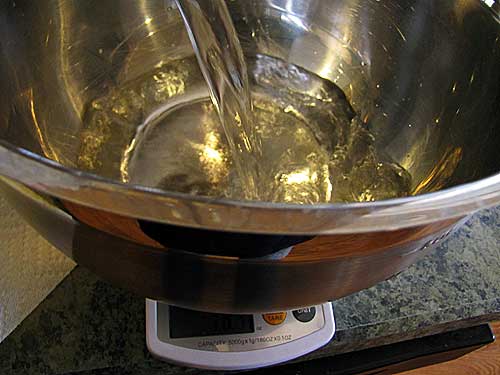
Weigh the lye.
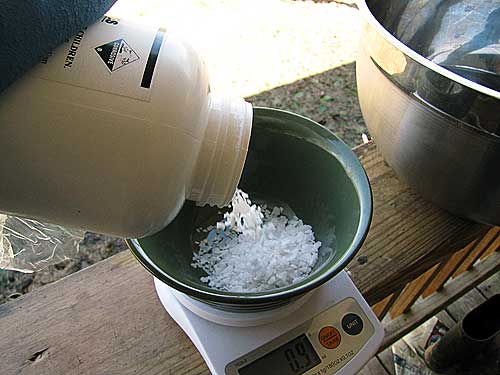
ALWAYS ADD LYE TO WATER. NEVER ADD WATER TO LYE. Add the lye gradually, stirring constantly. (I was taking a picture, but otherwise you should be stirring.)
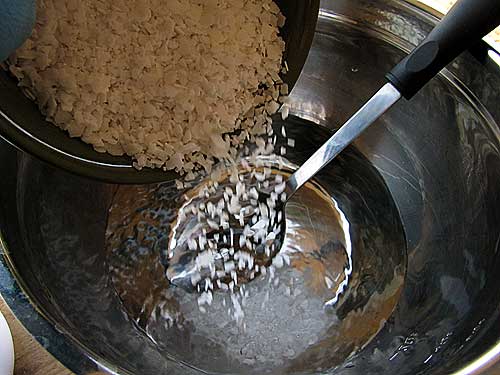
The mixture will appear cloudy at first.
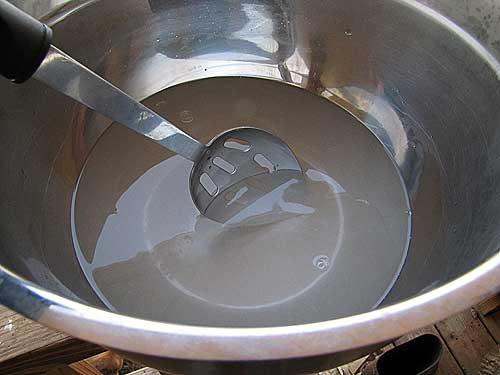
It will quickly clear.

Pour the lye solution slowly into the warm, melted oils. Your crock pot remains on Low.
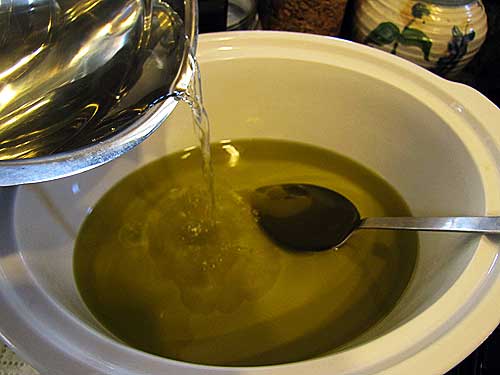
The mixture will darken and not look very appealing.

Place the stick blender in the crock pot, making sure the blade is completely immersed in the mixture to avoid creating splatters.
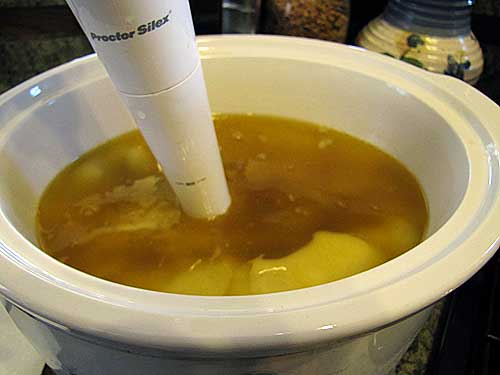
The mixture will turn opaque and become thicker and smoother as you blend it. To avoid burning up your stick blender, blend with it on for a few minutes, then turn it off and just stir with it. Then on, then off, as you watch for the mixture to come to trace.
What is trace? Trace is the stage in soapmaking where you can draw a line across the mixture and it will remain visible for several seconds before disappearing. (Sort of like when you’re making a thick gravy or a pudding.) Trace is even easier to recognize in a liquid soap recipe than a solid soap recipe. In fact, you can’t miss it. And it will go from starting to thicken to trace so fast, you will be lucky to get your stick blender out in time.
Right before trace:

A minute later, so thick I can’t shake the mixture off the stick blender, I have to scrape it off.
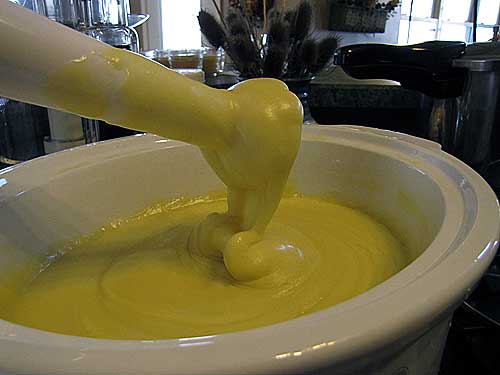
With the crock pot still on Low, put on the lid and begin the cook. Check it a couple of times during the first 30 minutes to be sure there’s been no separation of the oils. If you see any liquidy oils at the bottom of the crock pot, stir them back in.
The mixture will quickly become so thick, a spoon will stand up in it.

The paste will become very difficult to stir during the cook. Do your best. You can try a potato masher. It’s nearly impossible to stir at some points. Check the mixture about every 30 minutes during the cook and stir/break up/move it around the best you can to continue to mix the mixture as you watch for signs of finished paste.
Finished paste looks like thick Vaseline with a translucent quality.

Another look at a finished paste:
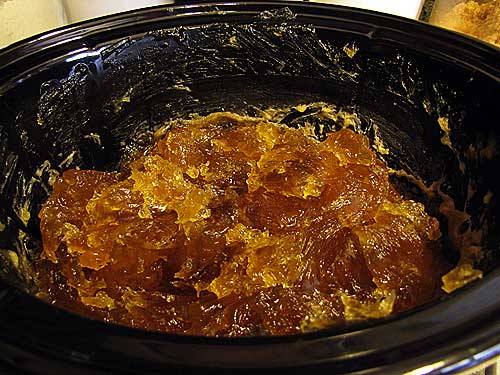
Finished paste close up in a sample:
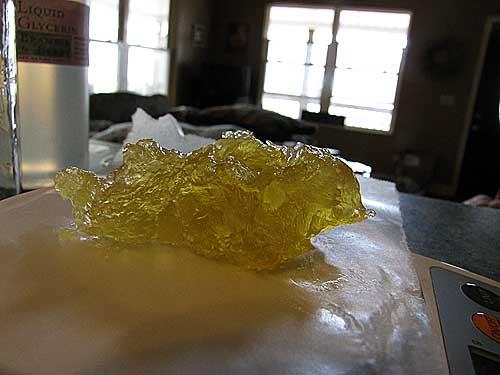
How do you know if your paste is finished? Aside from looks, you’ll need to dilute a sample to test.
Testing for finished paste:
Dissolve 1 ounce of soap paste in 2 ounces of boiling distilled water. If it tests clear, your paste is done. If it tests slightly cloudy but you’ve cooked for the expected period of time, that’s okay, you’re done. If it tests milky, you are so NOT done. (If it tests milky forever, you did something wrong. Probably mis-measured something.) In the recipes below, I’ve given you my cook times per recipe. Don’t test sample constantly. Wait at least 3 hours before test sampling, and then test sample about once an hour. Don’t be impatient, grasshopper. (Extra cook time will not hurt your soap, so never fear.) Tip: Start with 2 ounces of boiling water and the 1 ounce of soap paste–then zap 45 seconds in the microwave, stir, zap again, stir, zap again, several times over and your test sample will dissolve more quickly.
Sample testing clear (the paste is done):

Sample testing cloudy (this is still done):

Sample testing milky (NOT done!):

Once your paste is finished, weigh it. (You will need this information, and soap paste weight can vary, even when using the same recipe a second time, due to even slight differences in measurements, cook time, and evaporation.) You can either weigh your crock pot before you start (crock removed from outer heating pot) or remove the paste to weigh. I weighed my pot, but found later that when I tried to weigh the pot and paste combined, my scale couldn’t take it. It’s a pain, but not impossible, to remove the paste to weigh. Scrape it out with a big spoon and transfer to a bowl. You don’t have to get every last bit, just close enough. (Weigh the bowl first to deduct from the total weight or hit tare after you place the bowl on your scale and before you add the paste.) Weigh the paste, then return it to the crock pot.
You may at this point want to store half the paste for later use. As you move the paste back to the pot, keep your bowl on the scale and weigh out half the paste to return to the crock pot. Store the other half in a plastic baggie labeled with the recipe name and the weight of the paste for future reference. Depending on your rate of dilution, you might not even be able to dilute the entire paste in your crock pot anyway, but you will have no trouble diluting half the paste in your crock pot even at 20 percent dilution.
Another reason to divide your paste in half, or even in thirds, is to experiment with different dilution rates in preparing the soap. You may also want fragrance it in separate batches to please family members or friends, or make one part unscented for someone who doesn’t like scent while still fragrancing the rest. When you divide the paste, you have room to play with each part separately in dilution, scent, color, thickening, and so on.
Dilution:
Use soft or distilled water to dilute your paste. Here is a dilution table showing percent of soap and percent of water added per pound of paste.
For 15 percent soap — 48 ounces water (3 pounds) added per pound of paste
20 percent — 32 ounces (2 pounds)
25 percent — 22 ounces (1 pound 6 ounces)
30 percent — 16 ounces (1 pound)
35 percent — 12 ounces
40 percent — 9 ounces
Soaps made from 100 percent coconut oil will dilute at 40 percent (though that would be a very drying soap). You will have a hard time getting a recipe with any significant amount of olive oil to dilute at anything other than 20 percent. I started out trying all of my recipes at 30 percent. If a soap doesn’t dilute in a reasonable period of time (several hours) then you’re probably at the wrong dilution rate. A soap that isn’t going to dilute at your current dilution rate will start forming a layer on top. No matter how many times you break it up, it will keep layering.
An olive oil soap layering at 30 percent dilution:
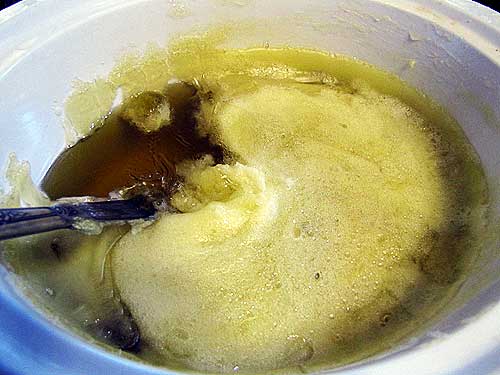
You have two choices. You can either dilute the soap further, or emulsify it with a 33 percent borax solution. Emulsification with a borax solution allows you to dilute soap at higher concentrations. Your other choice is to dilute further then thicken with glycerin. Borax is a natural mineral/salt. Glycerin is a byproduct of soap fats. Which path you choose will depend on the type of soap you’re making, its intended use, and your personal preferences. I used a borax solution to emulsify my home cleaning soap at 25 percent. For my hand soap and shampoo, I chose to dilute to 20 percent then thicken back with glycerin.
Your diluted soap weight = the weight of your paste plus the weight of your dilution water. (You will need this information, so after you finish diluting, add it up!)
Emulsification:
To emulsify liquid soap at a higher concentration than it will naturally dilute, add up to 2-3 tablespoons borax solution per pound of diluted soap. (See how to make a borax solution below.) If you choose to emulsify a recipe, you don’t need to add any further neutralization. You can do this before or after sequestering, but if you do it before sequestering, your soap is as clear as it’s going to get because this level of borax solution addition will interfere with further clearing.
Neutralization:
You can neutralize your liquid soap one of three ways–with citric acid, boric acid, or borax. You will add this to your diluted soap, but the amount you add is based on your paste weight.
To make a citric acid or boric acid solution (these two solutions are made at 20 percent), add 2 ounces of citric or boric acid to 8 ounces of boiling distilled water. Stir until dissolved. Use while hot. Add 1 1/2 tablespoons per pound paste weight to neutralize.
To make a borax solution (made at 33 percent), add 3 ounces of borax to 6 ounces of boiling distilled water. Stir until dissolved. Use while hot. Add 1 1/2 tablespoons per pound paste weight to neutralize. (Borax means, for example, the 20 Mule Team stuff.)
Following neutralization (or neutralization by emulsification), while your liquid soap is still hot, add (if using) scent, coloring, superfatting, thickening (if by glycerin), and sequestering agents.
Scent:
Add fragrance or essential oils, if desired, at 2-3 percent of your diluted soap.
Coloring:
You can dye your soap with specially prepared liquid soap dyes or use food coloring from the grocery store. (No, this won’t cause staining.) Fabric dyes are not recommended for liquid soap. Add color gradually–a few drops can color a lot of soap! Take into account that you are, with most clear liquid soap recipes, starting with a light to dark amber natural color.
I did color experiments in small samples, just for fun.

I usually prefer my homemade soaps in their natural color.
Superfatting:
Sulfated castor oil is the only recommended oil for superfatting liquid soap because it is completely water soluble. Other oils will cloud your liquid soap. Superfat at 1 percent of the diluted liquid soap weight.
Thickening:
For thickening purposes, add 1/2 to 1 ounce per pound of a 33 percent borax solution per pound of diluted soap. (Add to cold–aka room temperature–diluted soap.) If your soap is cloudy, do NOT use a borax solution for thickening until after sequestering. (This is more borax solution than used in neutralization and can interfere with clarity before sequestering.)
If you don’t want to use borax to thicken, add 1-2 ounces of glycerin per pound of diluted soap instead. Glycerin will also add moisturizing, lather, and emollience. You can add glycerin for thickening before sequestering as it is also a sequestering agent. Start with 1 ounce per pound diluted soap. Don’t expect to see the results of the glycerin until the soap cools and sequesters. After sequestering, if it’s not as thick as you like, you can add more.
Sequestering Agents:
You will already know from your test sample if your soap is slightly cloudy–and you can fix it now. (This will NOT fix milky liquid soap!) To clarify slight cloudiness, you can use isopropyl or ethanol alcohol, a sugar solution, or glycerin–or a combination of all three. Whatever mixture of sequestering agents you choose, add them at no more than 5 percent of your diluted liquid soap weight. To make a sugar solution, bring 1 pound of water to a boil. Add 1 1/2 pounds of sugar. Bring to a boil again and cook until the sugar dissolves.
Sequestering is the time the liquid soap sits before it clears. Some soaps are clear immediately. Others take days or up to 2 weeks to clear. Your liquid soap is ready to use immediately after you finish making it, but you may want to sequester some recipes for added clarity. I transfer my liquid soaps to quart jars for sequestering and storage. You may want to use something else, but clear glass enables you to see the soap as it’s sequestering, which is handy if you are looking for clarity. Save your empty water jugs and, after sequestering, transfer your soap to them for longterm storage and use to refill your dispensers.
You can print this page:  Printer-Friendly
Printer-Friendly
Recipes:
The Failor book is a fantastic resource and I highly recommend it. The book’s drawbacks are the way the information is organized and the lack of detail presented with the recipes. You have to flip back and forth hunting all over the book to find what you need when you need it, and recipes give no hint to suggested soft oils, recommended dilution rates, probable cook time, likelihood of cloudiness, etc. I’ve done my best with this tutorial to present the information as you need it, and to specify exactly how I made each recipe. These recipes are all adapted from the Failor book. You can replace the olive oil in these recipes with another soft oil (or combination of soft oils) and alter the dilution rate and other matters to your liking. If you do so, your results may be different. Feel free to experiment! For even more recipes and a lot of great resource information, get the Failor book. You can also create your own recipes using a liquid soap calculator.

Each of these recipes, the way I made them, yielded about 6 quart jars of liquid soap. Each quart jar of liquid soap weighs approximately 2 pounds, so that’s 12 pounds of soap!
I didn’t superfat any of these recipes, but you can. Remember also that if you want to dilute at a different rate, you could dilute all of these recipes at 30 or even 35 percent if you don’t mind emulsifying with a borax solution to the fullest recommended emulsification allowance. Homemade liquid soap is typically thinner than store-bought liquid soap. (Store-bought liquid soap is thickened.) How you make your recipes is all about what you want–do it your way.
How much did these soaps cost to make? I don’t know. I don’t like math and I didn’t figure it out. If you want the cheapest liquid soap possible, you can buy store-bought liquid hand soaps and shampoos for a dollar a bottle. You may not be able to make homemade liquid soap for that–but then, you might not want to know what’s in your cheap store-bought liquid soap. If you want to make homemade liquid soap for frugality purposes, find the best deals on lye and coconut oil. Use the cheapest soft oils you can find. Use borax to emulsify and thicken (borax is cheap) and don’t use any essential oils. If you want to make homemade liquid soap out of an interest in the craft or to provide the most natural, quality product you can for yourself and your family, then you will choose your ingredients with those goals in mind. (And your soap won’t be quite as inexpensive.) How much your liquid soap costs is up to you and it’s all about your perspective.
Moisturizing Hand Soap with Jojoba:
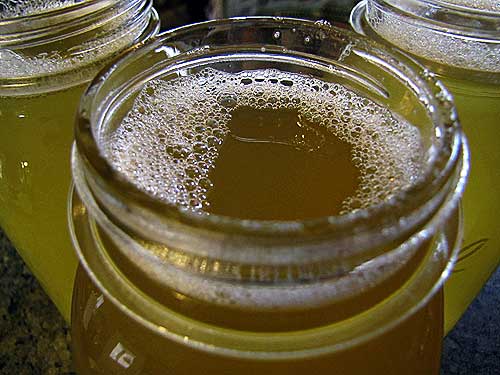
Notes: This recipe yields an initially slightly cloudy soap due to the jojoba. You’ll need to use sequestering agents to clear it up, and it will require sequestering time to clear and thicken. It also takes a very long cook time–but it’s worth it!
Oils
24 ounces coconut oil
10 ounces olive oil
10 ounces castor oil
3 ounces jojoba oil
Lye Solution
11 ounces potassium hydroxide
33 ounces distilled water
Trace Time: 15 minutes
Cook Time: 6 hours
Dilution Rate: 20 percent
Neutralization: 33 percent borax solution, 1 1/2 tablespoons per pound finished paste
Sequestering Agent: sugar solution, 5 percent per pound diluted soap
Thickening: 2 ounces glycerin per pound of diluted soap
Scent: 3 percent fragrance or essential oil per pound diluted soap
Moisturizing Shampoo with Lanolin:

Notes: This one also resulted in an initially slightly cloudy soap due to the lanolin, but not as cloudy as with the jojoba in the previous recipe. You can clear it up with sequestering agents. Even at 20 percent, it wasn’t completely diluted. Rather than dilute further, I added a reduced measure (1 tablespoon per diluted soap weight) of the 33 percent borax solution. If you prefer to not do that, you may have to dilute to 15 percent and increase the thickener. Since I emulsified slightly with the borax solution, added neutralization wasn’t necessary. If you don’t emulsify, neutralize. This soap was clear immediately after adding the sugar solution, but required sequestering time to thicken.
Oils
24 ounces coconut oil
13 ounces olive oil
11 ounces castor oil
2 ounces liquid lanolin
Lye Solution
12 ounces potassium hydroxide
36 ounces distilled water
Trace Time: 13 minutes
Cook Time: 5 hours
Dilution Rate: 20 percent
Emulsification: 33 percent borax solution, 1 tablespoon per pound diluted soap weight
Sequestering Agents: sugar solution, 5 percent per pound diluted soap
Thickening: 2 ounces glycerin per pound diluted soap
Scent: 3 percent essential oil per pound diluted soap
All-Around Home Cleaning Soap:
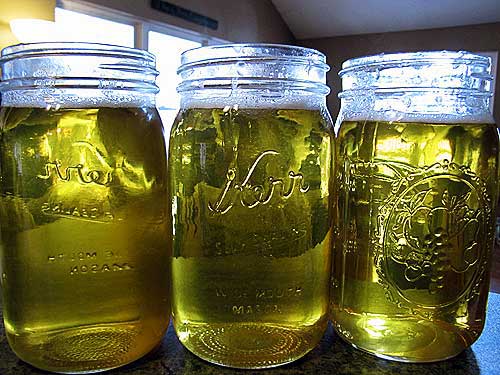
Notes: This recipe is the easiest one to make. (It’s a good one to pick to practice on first.) It cooks relatively quickly and is clear immediately. I used the highest proportion of borax solution recommended for emulsifying so I didn’t have to dilute further than 25 percent. The high olive oil content in this soap would make dilution difficult even at 20 percent. Since borax is a detergent agent and I intended this soap for home cleaning, I went right ahead with lots of borax. No further neutralization or thickening was needed.
Oils
23 ounces coconut oil
25 ounces olive oil
Lye Solution
12 ounces potassium hydroxide
36 ounces distilled water
Trace Time: 15 minutes
Cook Time: 4 hours
Dilution Rate: 25 percent
Emulsification: 3 tablespoons of 33 percent borax solution per pound diluted soap
Scent: several drops fragrance or essential oil per pound diluted soap
For laundry, I use this at 1/3 cup per load and add some washing soda and baking soda with a splash of vinegar. (How much washing soda and baking soda per load is up to you. You can find per-load recommendations on the side of the boxes. I use less than the manufacturers recommend because I think they recommend too much.)
You can use it straight up for washing dishes in the sink. It cuts grease! For the dishwasher, fill your dishwasher cups almost completely with it and add a little borax for detergent power.
Resource List (not exhaustive, but will get you started)
Supplies:
Wellington Fragrance
Bramble Berry
Summer Bee
Soaper’s Choice
Discussion/Questions:
Yahoo Liquid Soapers
CITR Liquid Soapers
Calculators:
Summer Bee
Bramble Berry
Soap Calc
Also:
The Catherine Failor book: Making Natural Liquid Soaps
Lye Safety Review
All My Soapmaking Posts and Tutorials
Soap Math
If you have trouble with all this soapy math (I do), here’s a tip. If you want to figure ounces for anything that’s in pounds, change the pounds to ounces (multiply the pounds by 16). To find a percent of anything, move the decimal two places to the left and multiply it. 2% = .02. Pounds times 16 times the percent (in a decimal). For example, say you want to fragrance six pounds of liquid soap at two percent. What is two percent of six pounds? 6 times 16 equals 96, and 96 times .02 equals 1.92 ounces. You’d add 2 ounces of fragrance.
You can print this page:  Printer-Friendly
Printer-Friendly
Happy liquid soaping!
Update five years later: If you got this far without running away screaming, congratulations. If you want an easier method that doesn’t involve math, see how I make liquid soap now, the easy way, here.


lizzie says:
Beautiful post Suzanne!! Thank you for taking the time to post this in depth liquid soap tutorial. Beautiful pictures! and very clear instructions. This will be my next to do!! :fairy:
On March 24, 2011 at 1:28 am
KentuckyFarmGirl says:
You got me hooked on making my own soap and my family says they will never allow me to go back to store bought (I agree!). I just have to find the time to make liquid soap now!!! Thank you for posting this!
On March 24, 2011 at 7:40 am
langela says:
This looks complicated. :bugeyed: Does it just look that way or does it take quite a bit of research learning before starting? I have made both cp and hp soaps. I think it’s all the dilution percentages that scares me. Maybe best left for a day when math makes more sense. :yes:
On March 24, 2011 at 8:40 am
Suzanne McMinn says:
langela, if you’ve made HP soap before, it’ll be really easy for you! Don’t be scared of the dilution percentages. Just take a small amount of your paste and experiment with it.
On March 24, 2011 at 8:43 am
holstein woman says:
Suzanne, this is wonderful, the time you took to make the soap and the time to post cost you in both ways. I will have to keep this and make it when I get the time. Terrific Job! :woof: :snoopy:
On March 24, 2011 at 8:52 am
Kim Gibson says:
Your posts are so clear and understandable! Thank you!
On March 24, 2011 at 9:03 am
Window On The Prairie says:
I’ve made soap in bars before, but not liquid. Thanks for the tutorial. (having done tutorials on my own blog I know how much work they are, so I really do appreciate it!)
Thanks,
Suzanne
On March 24, 2011 at 9:25 am
Melinda says:
Can the hand soap also be bath soap?? Approximately how much end product did you get from each of the three recipes you listed?
Great instructions as usual. I think this is my next project!
On March 24, 2011 at 10:17 am
Suzanne McMinn says:
Melinda, yes, you can use the soap however you want it to be used for. It could also be a shower soap etc. I got 6 quarts per recipe.
On March 24, 2011 at 10:23 am
Ramona says:
Wow, very informative. Maybe one of these days I’ll have time to do this kind of stuff.
On March 24, 2011 at 10:29 am
Melinda says:
6 quarts per recipe is a really good amount!!!
I have visions of no more shampoo or bath soap or dishwashing liquid….excuse me while I go daydream…. :snoopy:
On March 24, 2011 at 10:37 am
Suzanne McMinn says:
Melinda, just remember that how much any recipe yields depends on how you dilute it.
On March 24, 2011 at 10:44 am
MMT says:
I love my homemade bar soap, but have to admit that I have always found liquid soap much nicer and tidier to use. Does this liquid soap feel as creamy and luxurious to use as homemade bar soap? Gotta say that the dilution percentages kind of befuttle me, but I will definately give this a try. I need to get some potassium hydroxide, but have everything else I will need. Thanks for the tutorial, Suzanne!
On March 24, 2011 at 10:39 am
Suzanne McMinn says:
MMT, it depends on the recipe and the oils. I really love the recipes I listed here with the jojoba and the lanolin. They feel so soft on the skin. The one I listed as a cleaning soap is because that’s all I’d use that one for–it’s not a soft-soft soap like the ones with the jojoba and the lanolin.
On March 24, 2011 at 10:44 am
Amerayl says:
Great Post! You are the first person ever to make the dilution phase make sense to me. Thanks so much for that. Your soap looks great! I think it is funny that I made a batch today and I saw that you had posted this. I needed some to use in a toothsoap recipe. I think I’ll have to try the lanolin type for hand soap, it looks so lovely.
On March 24, 2011 at 4:34 pm
Marla says:
GREAT tutorial Suzanne. I haven’t made liquid soap yet, but been wanting to for a long time. Thanks to your tutorial I think I can do it now! :shimmy:
On March 25, 2011 at 9:24 pm
Sotheareth Ham says:
Hi everyone,
I used lye from ash water and mix with
oil then it is still trace.
Afterwards, I cook for two hours but it smell burnt.
Can you help me to make this liquid soap finished
with translucent?
On March 30, 2011 at 9:44 am
Suzanne McMinn says:
Sotheareth Ham–are you making soap from homemade lye, is that what you mean? I don’t have any experience with that, but you might try starting a topic for it on the Chickens in the Road forum and see if there is someone there who knows anything about it.
https://chickensintheroad.com/forum/
On March 30, 2011 at 9:52 am
Heather Gwinn says:
I just love your tutorial. I only wish I had found it just hours before I attempted my first liquid soap recipe. I used a lye calculator, did the recipe to a tee but I don’t think even after 12 hrs it turned clear but when it was hot. When it cooled it turned a bit more opaque. I ph tested it, a perfect 7. I diluted it by adding salt water solution to thicken it (aloe vera gel/ sea salt.) It thickened beautifully but now it’s got about a 1/2 inch cloudy white separation on the top of my bucket. What happened? Was it the aloe? Can I just skim it off and still use it?
I am hoping this is saveable. Any suggestions?
On April 14, 2011 at 2:12 am
Greg says:
Thank you for this very nice and helpful tutorial! I have a question about the citric acid solution. In your tutorial (and also have found it elsewhere) you write: “add 2 ounces of citric to 8 ounces of boiling distilled water. Stir until dissolved. Use while hot. Add 1 1/2 tablespoons per pound paste weight to neutralize.”
I am confused with ounces because sometimes are referring to weight and sometimes to volume. The quantities of citric acid and water you mention are ounces of weight or ounces of volume?
On June 9, 2011 at 8:35 am
Suzanne McMinn says:
Greg, those are in weight!
On June 9, 2011 at 9:08 am
rurification says:
Suzanne – I love this tutorial. Thank you so much for taking the time. It’s all beginning to make sense now.
Can you tell me how big your crock pot is? I want to make sure mine is big enough to handle the full recipe. [I’ve heard stories of erupting soap crocks. Don’t want to go there…]
I’ve been making bar soap for years. I’m so excited to try this!
On September 11, 2011 at 6:43 pm
Suzanne McMinn says:
Robin, I was using a 7-quart crock pot.
On September 11, 2011 at 6:50 pm
rurification says:
Thank you!! Ours looks big, but is only 5 qt. I’ll cut the recipe down. I can do that on one of the soap calc sites, right? The percentages will stay the same, but the amounts will be smaller. [fingers crossed…]
On September 11, 2011 at 8:33 pm
Sumicormi says:
I completely agree about how the book was laid out. The information is there but not organized at all. Poor editing maybe? Good job on your tutorial. Makes me want to try making liquid soap after all.
On January 7, 2012 at 12:42 pm
lkc says:
Way easier than I imagined!!! I made the all pupose household cleaner.
Coconut oil from essential depot: $0.21 / oz, olive oil from Sam’s Club: $0.13 / oz, KOH from essential depot: $0.27 / oz, Borax from Wal-Mart: $0.04 / oz, used filtered water from home: free, total cost: $11.56
This recipe: $0.96 / lb
Ajax at Wal-Mart: $1.85 / lb
Dr. Bronner’s: $8.49 / pound
A slight money saver if you buy the cheap stuff but the real savings is in the chemical free formula. Thank you for posting these recipes and for making sense of all the measurements, percentages, and instructions. It was intimidating the first time but after just one batch I am no longer afraid! This is a formula I can see myself using for years to come. I can not say thank you enough!!!! Thank you, thank you, thank you!!!
On February 1, 2012 at 10:41 am
ellie1777 says:
I made liquid shampoo yesterday from Failor’s book and it is too thin. Will it thicken during sequestering? I added 1 oz of glycerin for each pound of paste (4) and it didn’t help. When it is done sequestering, if it is still not thick can I thicken again with more glycerin. I used citric acid to neutralize because I read that it is better for small children instead of borax so I didn’t want to thicken the borax method. Frustrated after following the recipe and getting thin results, this is my first time making shampoo.
On February 16, 2012 at 7:05 am
Suzanne McMinn says:
Ellie, my shampoo came out thin also–you can thicken more with glycerin any time, but it will never be as thick as store-bought shampoo. The next time I make it, I’m planning to experiment some with the dilution and not dilute as much. It’s a hard balance to learn and takes experimenting!
On February 16, 2012 at 7:09 am
MookyCat says:
I absolutely LOVED your tutorial! Thanks so much for sharing!
Can oil be added to the soap once it’s been diluted, to make it more conditioning? I’m so used to my superfatted CP soaps, but my liquid soap feels almost too “balanced,” like there’s no conditioning ability. I made it using another recipe (not one of yours)- and found you by googling for a solution. I’m worried that if I add something now (maybe castor?) it will either separate out, or cloud the soap.
Thanks so much!
On February 17, 2012 at 8:37 am
Suzanne McMinn says:
MookyCat, it will probably cloud it, but that depends on whether you care! (And it may separate, so you’d have to shake before using.)
On February 17, 2012 at 8:40 am
crockett_n_becky says:
What type of hair does this shampoo work well on–i.e. oily, dry scalp, etc?
On March 27, 2012 at 10:34 pm
Suzanne McMinn says:
This is a shampoo for normal hair.
On March 27, 2012 at 10:49 pm
PippiL says:
I just wanted to thank you so very much for all the info.I was desperately looking around but couldn’t find much information about liquid soap.Right now I want to try making liquid soap without borax.
I’m sure it is harder,but I like a good challenge.Still working on my first batch, trying to get it right.
Thank you again,
Sincerely,
Marion
On March 28, 2012 at 1:02 am
NNaeve says:
Gorgeous pictures and thanks for the detailed description! I may try it.
I’m wondering what kind of coconut oil seems best to use – as a massage therapist I’m familiar with 3 types – 76 degree, fractionated, and that hard stuff you get in the store for eating which smells strongly of coconuts.
On October 4, 2012 at 4:10 pm
tempestuality says:
Very lovely post. Thank you for all the details. I also use the Failor book and was making a double recipe of hers of all coconut. It ended up overflowing my pot and I had to call my husband and scramble for another pot. Actually, I believe it is because my 3 year old son (while I stepped away for a moment) put sugar in the oil pan… so it saponified super quick. I was actually looking to see if I could find info about 100% coconut being clear or not. Mine is slightly cloudy, but not milky after 3 hours. I let it cook another hour, but honestly I believe it is done. I know it has some stearic and palmitic acids and that may lend to its cloudiness, and I am hoping after some sequestering it will clear.
I purchased tutorials from https://www.hotsoapmaking.com/ and she suggests just making each individual soap separately (Failor even comments that it would be easier to do as such), and then combine in any combination you see fit. So that is what I am doing. I am just debating on whether or not to neutralize, as I have made such a large amount, or wait to see what I want a particular amount for. Like I am about to make an all purpose cleaner and for that I would want Borax, but for shampoo I would want to neutralize and use glycerin. She also uses gums for thickening. I am about to try some of her recipes for the first time soon.
Anywho, the site is beautiful and well put together and thanks for your time and trouble! Hopefully I will be able to pull my site and blog together as well as yours :shimmy:
On October 11, 2012 at 1:54 am
tempestuality says:
Oh, one more thing I forgot to mention… When you mentioned Castor oil as being a superfatting oil, as it is the only soluble oil, you mean Sulphonated Castor oil, yes?
On October 11, 2012 at 1:56 am
Suzanne McMinn says:
Yes, that is correct re the sulphonated castor oil. You might also want to check out CindyP’s liquid soap tutorial:
https://ourlifesimplified.com/house/soap-recipes/homemade-liquid-soap-the-easy-way/#axzz20hoNy2Dl
She is far more expert than I on liquid soap!
On October 11, 2012 at 8:28 am
tempestuality says:
Thanks for the reply! After going to 4 hours of cook time and then dilution, it came out crystal clear. Thanks for the link!!!
On October 11, 2012 at 4:31 pm
freemotion says:
I just made my first soap paste and need to dilute it. Is it absolutely necessary to used distilled water? What will happen if I use the hard water from my tap?
On October 17, 2012 at 10:06 pm
Suzanne McMinn says:
freemotion, probably it will be fine. Distilled water is recommended for purity.
On October 17, 2012 at 10:10 pm
mcshafa says:
I was very happy to come across this .. very intelligible and encouraging tutorial. Pictures too are very clear. But it unfortunately did not answer my questions; but I know I can always get answers to my questions when I put them in the comments forum here since they are also about soap-making.
1 – Can I use the same procedure explained here for commercial soap-making?
2 – If there are fundamental changes in procedure, is there a way I can get to know that or be directed to another forum or tutorial page that can help?
Please help. I should appreciate it greatly.
McShafa
On October 23, 2012 at 7:02 am
jendebett says:
Can someone help me figure out if my math is right? I’m trying to figure out how much KOH to order. I’m making this for myself and a bunch of friends, and splitting it into gallon jugs… so i’m trying to figure out my cost/gallon.
i’m using the “easiest” recipe above that uses 12 oz of KOH. if the recipe fills 6 qt jars, it makes about 1.5 gallons of finished soap? so if i wanted to make at least 24 gallons of soap, i’d need to make about 16 batches, which would be approximately 192oz of KOH, or 12lbs…
is that right?
On November 14, 2012 at 6:43 pm
mooDz says:
hi suzzane .. thank you ..it’s an amazing post !
Ijust need to ask you a question I have done two experiments the process of lye mixing with other oils ( laurel oil , olive oila and castor oil )and it was successful like the photos you have but the proccess of cooking didnt succeed although the temperature was very low and i was stiring every half an hour for five hours .I hope u provide me with the proportion for one litre of liquid soap . Im waiting for your reply thank so much .
On February 23, 2013 at 10:44 am
MariaJ says:
:happyfeet: Thank you, Thank You, Thank you. I’m soooo happy I found you. Your pictures are GREAT & exactly what I needed. I have been very successful with shampoo but lacking in hand soap. I threw out a batch due to a 9.5ph & low sudsing. Also, recipes boast of a clear liquid soap & I’m expecting a crystal clear(like water) liquid, not amber. Well, I am getting a clear amber liquid & I see you color the amber liquid & it takes the coloring so well. I just recently learned about how to neutralize & thicken & the tips on sequestering & adding sugar are going to help me. Most recipes are 2:1 sunflower & coconut oil & are low sudsing…are there any with a super lather? I have learned everything on-line, but I think it’s time to buy Catherine Failors’s book. Many, many thanks….MariaJ
On March 22, 2013 at 10:23 am
Melissa T says:
Just wanted to say thank you! I have read the Failor book front to back several times and still felt like I “didn’t get it.” I read your post and finally “got it”. Made my first batch of liquid soap two weeks ago. Can’t wait to try it out!
On March 23, 2013 at 11:15 am
PeterBerg says:
Awesome tutorial Suzanne!!! I am a complete Newbie. Although as a house painter/stainer I am trying to create my own Linseed oil based “all green” wood siding preservative. So I have mixed up liquid soap using potassium hydroxide in my experimentations a couple of times. I loved your precise and very detailed instructions for the liquid soap, but I would like to use something other than Castor Oil on my body because Castor Beans can yeild the biotoxin, Ricin!!! Do you have any advice using Avocado Oil, or Chia Seed Oil instead. I’m thinking, that my ultimate recipe would be from smaller amounts of: Organic Coconut Oil, Organic Almond Oil, Organic Avocado Oil, Organic Chia Seed Oil, Organic Jojoba Oil, Organic Vegetable based Glycerin from Organic non-GMO’d Soy Beans or another healthy source, and using Citric Acid as the Neutralizer. And maybe adding in some Organic Shea Butter for more moisturizing or even Organic Beeswax as a thickener, if that is necessary. Also, maybe some Organic Rosemary or Lemon essential Oil. Any suggestions on calculating recipes using just a few of these or all of them in a recipe? I’d really prefer not to use Castor Oil or Boric Acid if I don’t have to. Also, do you have a book with recipes and calculating instructions? Or what would you suggest for a first timers book on mainly Liquid Soap Making, All Organic, healthy Shampoos, Shower Gels, Laundry and liquid Dish Soaps, Lotions, plus, maybe even all Organic, healthy (I don’t use the term “All Natural, because that is meaningless today,) Cosmetics for my wife. Sorry for all the questions, but there is allot of info. out there that adds ingredients that are really not good for you. I’d like to keep it completely, all good stuff. I don’t know if there is a book out there that caters to this kind of strict regimen, but any and all suggestions would be greaatly appreciated.
Peter B.
On April 25, 2013 at 4:05 pm
amysapothecary says:
Hi I cannot thank you enough for this amazing information about ls. It’s why I tried my first batch of liquid soap last week. Even though it wasn’t a fabulous success because I veered off the beaten path as I tend to do, I am wanting to make liquid laundry soap. I was wondering if I make your homemade liquid cleaner as per above, can i just go ahead and add the baking soda and washer soda (I’m not sure where i can find that) and the splash of vinegar to the solution and store? Can I also use this in my dishwasher too if I add the “extras” ?
My other question was about the shampoo. The liquid lanolin part, can I use the stuff found on the baby isle for breast feeding moms? Or is that too solid?
Thanks so much for the beautiful site and amazing information
On May 5, 2013 at 12:52 pm
dbish says:
Hello Suzanne,
Thanks for the great post. I really appreciate the insight you have to share. Do you have any suggestions on where to look for properties of different oils as far as what may clean well for dishes and laundry?
I am also a little confused by when you wrote: “To make a citric acid or boric acid solution (these two solutions are made at 20 percent), add 2 ounces of citric or boric acid to 8 ounces of boiling distilled water. Stir until dissolved. Use while hot. Add 1 1/2 tablespoons per pound paste weight to neutralize.
To make a borax solution (made at 33 percent), add 3 ounces of borax to 6 ounces of boiling distilled water. Stir until dissolved. Use while hot. Add 1 1/2 tablespoons per pound paste weight to neutralize. (Borax means, for example, the 20 Mule Team stuff.)”
I am confused when you say to dilute the different neutralizer with water but then say use 1 1/2 tablespoon per pound. Are you saying after you dilute the neutralizer with water, you should use 1 1/2 tbsp of that solution? If not can you please clarify? I would really appreciate it. Thank you.
On May 12, 2013 at 11:52 pm
blackice says:
Thanks so much for the great tutorial! The instructions are clear and easy to understand, and the photos are helpful, too. I was so happy to end up with perfect soap by following your instructions.
On June 27, 2013 at 3:57 am
Jay Ellen says:
This is great! love… love… love it… All I need is the garage sale crock pot! :snoopy:
On August 4, 2013 at 2:59 pm
miraculousbeads says:
I found two things not mentioned here: Since KOH doesn’t heat up the water, should I warm up the water before adding it?
Also, is adding a preservative necessary?
On August 6, 2013 at 11:32 am
crzybutterflylvr says:
HI I’m wondering if you can help me out. I have Failor’s book “Making Natural Liquid Soap” and it’s so hard to follow. I stumbled across your post looking for some help and it is so informative! My last batch of Baby Wash/Shampoo came out great. It was mostly Castile Soap with a small amount of Coconut Oil to help with the lather. This time around I was trying to make a Jojoba Conditioning Shampoo. I measured everything out according to the Lye Calculator on Summerbeemeadow.com. I started blending it with the stick blender and it immediately turned into a beautiful creamy color. As I was blending it, it turned to trace really really quick. I could barely get the stick out of the mix. I’m doing it in a crock pot. I started it on a Friday and cooked it overnight until today. I’ve tested it twice and it’s still very cloudy and opaque colored. I read in your blog if it does that, something got screwed up. I guess I’m trying to find out if this is still good or is it a wasted batch? I also noticed that my last batch was more runny and not as thick as store bought shampoo. Besides glycerin is there anything else you can thicken it up with? What about guar gum? I appreciate you getting back to me so I know what to do with this current batch of soap.
On September 14, 2013 at 2:05 pm
lyoness876 says:
I made my very first batch of liquid soap (finished this morning), and it is AWESOME! Thank you so much for your tips! I do have 1 to add though, especially for 1st time makers: Do NOT over blend. Once it hit the trace STOP mixing, or it will bubble and overflow everywhere. And I mean EVERYWHERE. 🙂
On February 8, 2014 at 1:19 pm
aphrodemon says:
I’m a newbie for liquid soap =D and the liquid soap making information you’ve provided is very comprehensive and thoroughly, thank you so much for doing this. I do have a question on your Moisturizing Shampoo with Lanolin recipe. If the shampoo is to be thickened, with the use of borax, would it be too drying? I’m wondering the same thing for your liquid hand soap recipe as well.
Another question: if I was to sequester and thicken my diluted soap, would my soap be more diluted after using the two methods?
I beg a pardon, I have another question =) After sequestering my diluted soap, how long should I wait to see result before I do another sequestering?
On February 11, 2014 at 6:23 am
Suzanne McMinn says:
I don’t find it drying, but it depends on what I’m using the soap for. You can choose not to use the borax, just thicken later with glycerin. Your soap should not be noticeably more diluted after sequestering, and sequestering time can vary wildly!
Re cleaning the immersion blender, I hold it under hot water. If that doesn’t clean quickly enough to suit me, I put the end down in a bowl of hot water to soften the soap and make it clean off more easily.
On February 11, 2014 at 12:41 pm
aphrodemon says:
How do you clean your immersion blender? Esp where your paste is so thick that you can’t blend it anymore, does this paste get stuck under the inner side of the blade?
On February 11, 2014 at 7:15 am
DENBUR says:
:sheepjump: :sheepjump: I made liquid soap and it turned out looking just like your last picture except it has a white scum on top. When I try to pour it mixes right back in soap and it becomes cloudy again. any ideas?
DENBUR
On May 7, 2014 at 1:48 pm
ArtisanShelly says:
I have been reading EVERY WORD and I LOVE what I am reading!! I have tried to make liquid soap following all kinds of recipes on the internet only to fall short in the success of it each time. But onward I go, my search has not ended but I do believe this Chicken in the Road place is a Starting Point to NEW SUCESS!! :sun:
Here is my Question: I want to make BODY WASH….So, from what I have been reading above, I can MAKE to soap BE whatever I need it to be. That being said, you have directions for shampoo that are different from hand soap that are different from dish soap….see my point?? So, I want BODY WASH, so my Question is this:
What exactly do I need to do to make this liquid soap into BODY WASH?
Their has to be SOMETHING that makes the Body wash DIFFERNT Than the Shampoo, etc…
Also for my NEXT QUESTION:
If I were to make this, how would I lable it? Would I SAY that this is an ALL NATURAL BODY WASH? ORGANIC? HANDMAD? OTHER? I want to label it in such a way that will help SAY exactly what the product is. Also, it sounds like reading above, that if I use Borax (Is that Borax 20 Mule?) that I CANT place a Sticker stating that this is ALL NATURAL, but if I ONLY use Glycerin instead to thicken the liquid, then I can….Right?
Ok, thanks SO MUCH, and please know that I will be patient in your reply, I know how BUSY you are and the others that might Chime In. SMILES, and I hope you have the BEST DAY EVER!!! 😀
On June 2, 2014 at 9:42 pm
dessie says:
How many ounces does each recipe make. I was thinking about making the jojoba oil recipe. If I didn’t care about making it clear what steps do I skip. I want it thick but don’t care about it being clear. You call the lanolin recipe a shampoo but could you use it as a hand soap.
On July 16, 2014 at 10:33 am
michael vennard says:
Dear,
Its all good stuff but one glaring mistake you need to correct quickly or everything will be a mess, Borax cannot neutralize as it has a pH of 9.3 which is almost the same pH you have after saponification , the Citric acid or Boric acid is ok but a but dubious health wise for Boric acid so better stick to the Citric acid or just use Lemon juice….dont want all your friends to get horrible rashes with caustic soap which has not been neutralized…you can google pH Borax and see straight away
cheers
Mike
On January 25, 2015 at 9:29 pm
tinawhalen says:
Hi Suzanne. I tried making a borax solution but it doesn’t dissolve at all. How do you get it to work?
On February 25, 2015 at 10:33 am
Suzanne McMinn says:
It should dissolve! Is your borax old, or gotten really hard somehow?
On February 25, 2015 at 10:35 am
tinawhalen says:
not hard, a few small lumps. but I didn’t know it had a shelf life, the box is over a year old.
On February 25, 2015 at 10:46 am
tinawhalen says:
even when it was a fresh box though, and my fiance used it directly in the washer, it wasn’t dissolving much if at all. why I stopped using it. I am experimenting with it to see if it will help my own laundry soap recipe to emulsify. I use a hard soap recipe, grate a bar of it and dissolve in water but it likes to become a mass of glop. works fine anyway, just makes it hard to pour a reasonable amount into a wash load without using alot of it LOL.
On February 25, 2015 at 10:49 am
tinawhalen says:
OK so I tried a new box of borax and it still doesn’t dissolve in hot water. But it still does what I want it to by loosening the glob of soap to be more liquid.
On March 1, 2015 at 3:02 pm
Lena says:
Hi, I tried making a batch yesterday, and after about four hours part of the soap had a translucent quality, but part of it didn’t. I saw a video where someone did a test batch on it at that point, so I decided to try. The test batch came out fine, then I left a fraction to dissolve overnight, and it seems milky (plus way too watery, I put boiling water in the crockpot, then left it on and it boiled away, so I added more, I don’t know if that’s the problem…). I’m not sure if it’s not done, but if so, can I just put the batch back in the pot and continue cooking after it’s clean?
On May 14, 2015 at 10:19 am
tinawhalen says:
So I finally tried a liquid soap base yesterday. Total failure, thankfully it wasn’t an expensive oil, just lard. Can you tell me what went wrong? I can tell you that the lye cooled off to around 94 degrees by the time my lard was melted then cooled down to about 116. Also, because my blender was heating up too much, I grabbed another one and it started causing too much air to get into the mix; I even went to a third one, and still after about an hour (I think!) of blending, it barely went to a light trace. Letting it cook with the lid on, it just kept foaming and wouldn’t turn to paste. Tried removing the lid to see if cooking off more water would help, but nope. Tossed the vat of fat out this morning.
On November 20, 2017 at 11:53 am